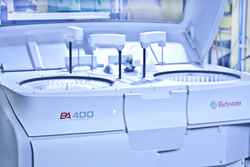
Posted to News on 16th Sep 2016, 11:00
Clinical diagnosis benefits from design collaboration
Precision and reliability are two critical requirements of testing and analysis for clinical diagnosis; a collaborative project has now combined these with efficiency and cost effectiveness by designing a new modular microfluidic product. Integrating the design expertise of Brkert Fluid Control Systems with the long-standing experience of Biosystems, a prominent manufacturer of analysis equipment, has resulted in the design of a new dosing unit that significantly reduces running costs for analysis instrumentation.

The new dosing unit forms one of the cores of the new BA400 analysis device, which is designed to carry out fully automatic analysis of up to 400 tests per hour. The operator prepares the device with the corresponding samples and reagents before starting the analysis process. The design of the new dosing unit has also reduced water and material consumption, which allows the analyser to operate continuously for 8 hours without intervention to replace or refill containers.
The work of clinical analysis equipment as used in human medicine is hugely important but the pressure to reduce both capital expenditure and running costs is increasing on a daily basis. The ultimate solution then requires innovation that, at the same time, is accepted as proven technology and so is suitable for operation on a device used in a context, where a pedigree for reliability is essential.
Biosystems is a Spanish manufacturer of clinical diagnostics products that aims to streamline workflow and enhance operational efficiency and improve patient treatment. To that end, the company has developed a new analysis device that is to be used for in-vitro diagnostics (IVD), through collaboration with Brkert, which has provided significant design and manufacturing expertise for the control and monitoring of the fluids.
The aim of the project was to develop a modular dosing unit that would be suitable not only for use on the new system, but also for existing analysis devices available from Biosystems. This posed a considerable design challenge that would need to integrate the various components such as the injection unit, two or three valves, a pressure sensor and a filter, all of which would be mounted onto a transparent, injection-moulded structure.
The product required considerable design skill and expertise in fluid control in order to deliver very high dosing precision in a very compact space. The engineers at Biosystems decided to take advantage of the Brkert Systemhaus facilities that offer bespoke designs that can be manufactured and assembled in-house.
One of the crucial aspects of the design was the detection and prevention of air bubbles which can substantially corrupt the analysis results. Coupled with the client's requirement for a transparent inspection window, it was essential that the Brkert designers avoid any rough surfaces, dead zones and sharp edges while creating the new dosing unit.
Engineers developed an injection-moulded component that would house the control elements and machined it in such a way that all of the internal passages had a very high-quality surface finish. The control valves, based on the Type 0127 solenoid valve and the Type 6628 Twin Power rocker solenoid valve, were positioned to minimise dead zones and deliver maximum flexibility of control.
The Brkert solenoid valves have been specifically designed to deliver complete back pressure tightness, excellent flushability and a low internal volume while offering precision switching of micro volumes. In addition, the basic design of these solenoid valves ensures complete fluid separation that enables them to be used with aggressive fluids, which is essential for applications using specific cleaning chemicals as part of the process.
The cooperative approach to the design and manufacture of the new dosing unit has brought together technological innovation and a desire to overcome the technical challenges associated with the development of a unique piece of equipment. The final design can be used in a number of analysis devices, thanks to its flexibility, which means that the overall demand for the product increases. This increases the demand for components and reduces manufacturing costs, making the new dosing unit a very cost effective project for the client.
More information can be found at www.burkert.co.uk.
Want the latest machine building news straight to your inbox? Become a MachineBuilding member for free today >>
Fluid Control Centre
1 Bridge End
GL7 1QY
UNITED KINGDOM
+44 (0)1285 648720















